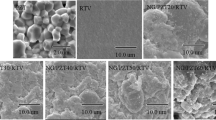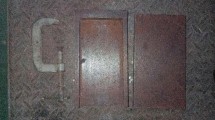Abstract
This study examines the elastic and dielectric properties of active composites consisting of barium titanate (BaTiO3) and silver (Ag) constituents using experimental and numerical approaches. The elastic constants including Young’s modulus, shear modulus and Poisson’s ratio were measured by resonant ultrasound spectroscopy (RUS), a nondestructive dynamic technique, while a dielectric (impedance) spectroscopy was used to measure the relative permittivity and dielectric loss at different frequencies. The dielectric tests were also conducted at temperature ranges from −50 to 200 °C where the two phase transformations of barium titanate at around 0 °C and 120 °C were examined. The experimental results in this study were compared to data available in the literature. In addition to the experimental work, a numerical method is also considered in order to study the effects of blending silver into barium titanate on the effective elastic and dielectric properties of the composite and the local field fluctuations. For this purpose, two micromechanics models describing the detailed composite microstructures were constructed. The first model is based on two dimensional (2D) images of realistic microstructures obtained by the scanning electronic microscopy (SEM), while the second model is based on randomly generated three-dimensional (3D) microstructures with spherical particles. The effects of loading direction, porosity, particle shape and dispersion were examined using the micromechanics models. Numerical predictions of the effective elastic and dielectric constants were compared to the experiment results.















Similar content being viewed by others
References
Hennings D (1987) Barium titanate based ceramic materials for dielectric use. International journal of high technology ceramics 3(2):91–111
Takenaka T, Maruyama K-i, Sakata K (1991) (Bi1/2Na1/2) TiO3-BaTiO3 system for lead-free piezoelectric ceramics. Jpn J Appl Phys 30(9S):2236
Chen C, Tuan W (1999) Mechanical and dielectric properties of BaTiO3/Ag composites. J Mater Sci Lett 18(5):353–354
Kojima T et al (2009) Fabrication of BaTiO3/Ag composites using uniform Ag-deposited BaTiO3 particles. J Ceram Soc Jpn 117(1372):1328–1332
Panteny S, Bowen C, Stevens R (2006) Characterisation of barium titanate-silver composites, part I: microstructure and mechanical properties. J Mater Sci 41(12):3837–3843
Panteny S, Bowen C, Stevens R (2006) Characterisation of barium titanate-silver composites part II: electrical properties. J Mater Sci 41(12):3845–3851
Liu X, Fan H, Shi J (2013) Effect of silver addition on the microstructures and electrical responses of La (1.7) Sr (0.3) Mo (2) O (9− δ) ceramics. Mater Res Bull 48(1):58–62
Wang X et al (2012) A simple route to disperse silver nanoparticles on the surfaces of silica nanofibers with excellent photocatalytic properties. Mater Res Bull 47(7):1734–1739
Zhang Y et al (2013) Ag/BiPO 4 heterostructures: synthesis, characterization and their enhanced photocatalytic properties. Dalton Trans 42(36):13172–13178
Bechmann R (1956) Elastic, piezoelectric, and dielectric constants of polarized barium titanate ceramics and some applications of the piezoelectric equations. The Journal of the Acoustical Society of America 28(3):347–350
Berlincourt D, Jaffe H (1958) Elastic and piezoelectric coefficients of single-crystal barium titanate. Phys Rev 111:143
Dunn ML (1995) Effects of grain shape anisotropy, porosity, and microcracks on the elastic and dielectric constants of polycrystalline piezoelectric ceramics. J Appl Phys 78(3):1533–1541
Rödel J, Kreher W (1999) Effective properties of polycrystalline piezoelectric ceramics. Le Journal de Physique IV 9(PR9):Pr9-239–Pr9-247
Den Toonder J, Van Dommelen J, Baaijens F (1999) The relation between single crystal elasticity and the effective elastic behaviour of polycrystalline materials: theory, measurement and computation. Model Simul Mater Sci Eng 7(6):909
Froehlich A, Brueckner-Foit A, and Weyer S (2000) Effective properties of piezoelectric polycrystals. Proc. SPIE 3992, Smart Structures and Materials: Active Materials: Behavior and Mechanics, pp 279–287. doi:10.1117/12.388212
Dent A et al (2007) Effective elastic properties for unpoled barium titanate. J Eur Ceram Soc 27(13):3739–3743
Duran P et al (2002) Densification behaviour, microstructure development and dielectric properties of pure BaTiO 3 prepared by thermal decomposition of (Ba, Ti)-citrate polyester resins. Ceram Int 28(3):283–292
Arya PR et al (2003) Polymeric citrate precursor route to the synthesis of nano-sized barium lead titanates. Mater Res Bull 38(4):617–628
Buscaglia V et al (2004) Nanostructured barium titanate ceramics. Powder Technol 148(1):24–27
Boulos M et al (2005) Hydrothermal synthesis of nanosized BaTiO 3 powders and dielectric properties of corresponding ceramics. Solid State Ionics 176(13):1301–1309
Stojanovic B et al (2005) Ferroelectric properties of mechanically synthesized nanosized barium titanate. Ferroelectrics 319(1):65–73
Vinothini V, Singh P, Balasubramanian M (2006) Synthesis of barium titanate nanopowder using polymeric precursor method. Ceram Int 32(2):99–103
Simon-Seveyrat L et al (2007) Re-investigation of synthesis of BaTiO 3 by conventional solid-state reaction and oxalate coprecipitation route for piezoelectric applications. Ceram Int 33(1):35–40
Zgonik M et al (1994) Dielectric, elastic, piezoelectric, electro-optic, and elasto-optic tensors of BaTiO 3 crystals. Phys Rev B 50(9):5941
Arlt G, Hennings D (1985) Dielectric properties of fine-grained barium titanate ceramics. J Appl Phys 58(4):1619–1625
Moulson AJ, Herbert JM (2003) Electroceramics: materials, properties, applications. Wiley
Guo L et al (2006) Microwave hydrothermal synthesis of barium titanate powders. Mater Lett 60(24):3011–3014
Zhao Z et al (2004) Grain-size effects on the ferroelectric behavior of dense nanocrystalline BaTiO 3 ceramics. Phys Rev B 70(2):024107
Kim HT, Han YH (2004) Sintering of nanocrystalline BaTiO 3. Ceram Int 30(7):1719–1723
Karaki T et al (2007) Lead-free piezoelectric ceramics with large dielectric and piezoelectric constants manufactured from BaTiO3 nano-powder. Jpn J Appl Phys 46(2L):L97
Ren P et al (2011) Effects of silver addition on microstructure and electrical properties of barium titanate ceramics. J Alloys Compd 509(22):6423–6426
Shi J et al (2015) Bi deficiencies induced high permittivity in lead-free BNBT–BST high-temperature dielectrics. J Alloys Compd 627:463–467
Liu G et al (2016) Colossal permittivity and impedance analysis of niobium and aluminum co-doped TiO 2 ceramics. RSC Adv 6(54):48708–48714
Liu Z et al (2017) Duplex structure in K 0.5 Na 0.5 NbO 3-SrZrO 3 ceramics with temperature-stable dielectric properties. J Eur Ceram Soc 37(1):115–122
Böhm HJ (2013) A short introduction to basic aspects of continuum micromechanics. Cdl-fmd Report 3
Eshelby JD (1957) The determination of the elastic field of an ellipsoidal inclusion, and related problems. In: Proceedings of the Royal Society of London A: Mathematical, Physical and Engineering Sciences. The Royal Society
Mori T, Tanaka K (1973) Average stress in matrix and average elastic energy of materials with misfitting inclusions. Acta Metall 21(5):571–574
Hill R (1965) A self-consistent mechanics of composite materials. Journal of the Mechanics and Physics of Solids 13(4):213–222
Rasool A, Böhm HJ (2012) Effects of particle shape on the macroscopic and microscopic linear behaviors of particle reinforced composites. Int J Eng Sci 58:21–34
Tajeddini V et al (2014) Average electo-mechanical properties and responses of active composites. Comput Mater Sci 82:405–414
Langer SA, Fuller ER Jr, Carter WC (2001) OOF: image-based finite-element analysis of material microstructures. Computing in Science & Engineering 3(3):15–23
Gudlur P et al (2014) On characterizing the mechanical properties of aluminum–alumina composites. Mater Sci Eng A 590:352–359
Gudlur P, Muliana A, Radovic M (2014) Effective thermo-mechanical properties of aluminum–alumina composites using numerical approach. Compos Part B 58:534–543
Gudlur P, Muliana A, Radovic M (2014) The effect of microstructural morphology on the elastic, inelastic, and degradation behaviors of aluminum–alumina composites. Mech Res Commun 57:49–56
Muliana AH (2010) A micromechanical formulation for piezoelectric fiber composites with nonlinear and viscoelastic constituents. Acta Mater 58(9):3332–3344
Xing J, Radovic M, and Muliana A (2016) Thermal properties of BaTiO 3/Ag composites at different temperatures. Composites Part B: Engineering
Radovic M, Lara-Curzio E, Riester L (2004) Comparison of different experimental techniques for determination of elastic properties of solids. Mater Sci Eng A 368(1):56–70
Gudlur P et al (2012) Thermal and mechanical properties of Al/Al< sub> 2</sub> O< sub> 3</sub> composites at elevated temperatures. Mater Sci Eng A 531:18–27
Flynn K, Radovic M (2011) Evaluation of defects in materials using resonant ultrasound spectroscopy. J Mater Sci 46(8):2548–2556
Cheng B et al (1996) Mechanical loss and Young's modulus associated with phase transitions in barium titanate based ceramics. J Mater Sci 31(18):4951–4955
Marutake M (1956) A calculation of physical constants of ceramic barium titanate. J Phys Soc Jpn 11(8):807–814
Roberts S (1947) Dielectric and piezoelectric properties of barium titanate. Phys Rev 71(12):890
Nguyen V-D et al (2012) Imposing periodic boundary condition on arbitrary meshes by polynomial interpolation. Comput Mater Sci 55:390–406
Jiang M, Jasiuk I, Ostoja-Starzewski M (2002) Apparent thermal conductivity of periodic two-dimensional composites. Comput Mater Sci 25(3):329–338
Keip M-A, Steinmann P, Schröder J (2014) Two-scale computational homogenization of electro-elasticity at finite strains. Comput Methods Appl Mech Eng 278:62–79
Schröder J, Labusch M, Keip M-A (2016) Algorithmic two-scale transition for magneto-electro-mechanically coupled problems: FE2-scheme: localization and homogenization. Comput Methods Appl Mech Eng 302:253–280
Pahr DH, Zysset PK (2008) Influence of boundary conditions on computed apparent elastic properties of cancellous bone. Biomech Model Mechanobiol 7(6):463–476
Lin CH, Muliana A (2014) Polarization Switching Responses of 1-3 and 0-3 Active Composites. Compos Struct 116:535–551
Acknowledgements
Part of this research is sponsored by the National Science Foundation under grant CMMI-1437086.
Author information
Authors and Affiliations
Corresponding author
Rights and permissions
About this article
Cite this article
Xing, J., Radovic, M. & Muliana, A.H. Elastic and Dielectric Properties of Active Ag/BaTiO3 Composites. Exp Mech 58, 645–660 (2018). https://doi.org/10.1007/s11340-017-0271-5
Received:
Accepted:
Published:
Issue Date:
DOI: https://doi.org/10.1007/s11340-017-0271-5




